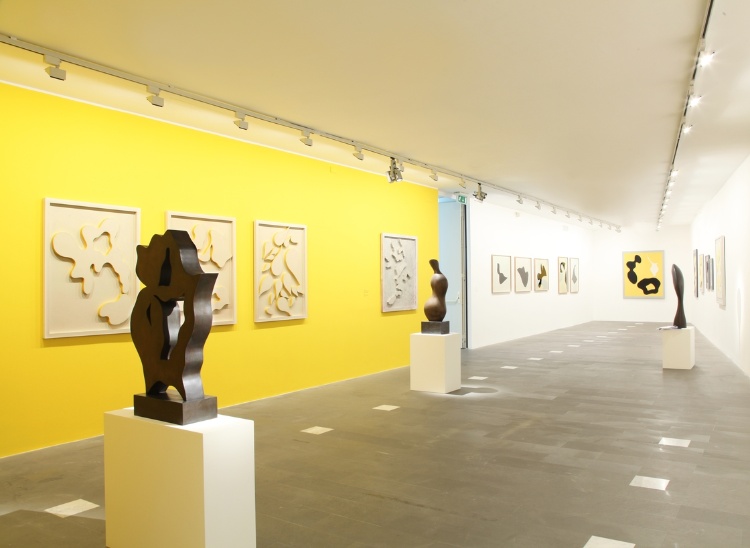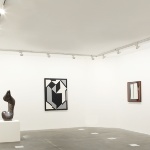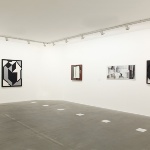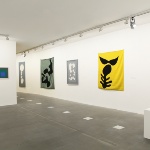
Main site sections
Arp’s Galaxy
15.11.2013
-
16.02.2014
MAN is pleased to announce a new exhibition entitled “Arp’s Galaxy” that will be held from November 15, 2013 to February 16, 2014.
Stemming from collaboration with the city of Locarno, the exhibition, curated by Lorenzo Giusti and Rudy Chiappini, reconstructs the complex network of the French/Swiss artist’s relationships with some of the leading figures of the European avant-garde through the presentation of a significant group of works mostly on loan from the City of Locarno but also from the Galleria Nazionale d'Arte Moderna in Rome and from Intesa Sanpaolo and other private collections.
Along with an important series of sculptures, bas-reliefs, tapestries and papers by Jean Arp (Strasbourg 1887 - Basel, 1966), the exhibition will present significant works by great 20th century artists including Alexander Calder, Max Ernst, Paul Klee, André Masson, Meret Oppenheim, Francis Picabia, Kurt Schwitters and Josef Albers, Julius Bissier, Sonia Delaunay, Theo Van Doesburg, Piero Dorazio, Viking Eggeling, Fritz Glarner, Richard Huelsenbeck, Johannes Itten, Marcel Janco, Richard Paul Lohse, Alberto Magnelli, Sebastián Matta, Aurélie Nemours, Hans Richter, Arthur Segal, Italo Valenti, Victor Vasarely.
The MAN exhibition will reunite some of Arp’s most famous sculptures from the beginning of the 1950s to the mid-60s: Hurlou, Pas encore de titre, Feuille-miroir and Torse-amphore. They represent the artist’s unique approach to the creation of organic forms. Also included are twelve extraordinary reliefs made by Arp during the period of his full creative maturity along with two tapestries and a series of large collages and decoupages.
A second section will host works by the group of artists who shared a significant part of their creative process with Arp - as well as their friendship. These include: Paul Klee, one of the most renowned 20th century artists, investigator of the expressive possibilities of the line as an independent figurative element; Max Ernst, a leading exponent of Surrealism, author of images in which figuration and abstraction coexist; Alexander Calder, author of his famous "mobiles" - abstract suspended sculptures which move by air currents - influenced by Arp’s language. The exhibition also features works by Theo Van Doesburg, representing the neoplastic current; Sonia Delaunay, Ukrainian painter and wife of Robert Delaunay, who worked alongside her husband on simultaneist pictorial research; Alberto Magnelli who, in close contact with the Delaunays and Arp between 1939 and 1944, experimented with new forms of expression in line with the research of the Abstraction-Création group; Meret Oppenheim, Swiss painter and sculptor, author of surprising, surrealist-inspired objects; and Victor Vasarely, painter and graphic designer, originally Hungarian, first in contact with the Abstraction-Création group and then founder of the "optical" movement.
The collection of the City of Locarno was founded in 1965 thanks to a donation by Jean and Marguerite Arp; it originally included 26 sculptures and reliefs by Arp in addition to a large number of works by other artists with whom Jean and Marguerite had been friends: Sophie Taeuber, Theo Van Doesburg’s first wife, Marcel Janco, Wilfredo Arcay, Alexander Calder, Richard Mortensen, Antoin Poncet , Lajos Kassak , Günther Fruhtrunk, Arthur Segal and Victor Vasarely. Other works were later added to this first group and helped define the current collection which now includes prominent authors from the history of 20th European art. Although amassed spontaneously without a precise development plan, over time Locarno’s Arp Collection has acquired its definitive physiognomy in the field of abstraction today representing an important part of the history of the European avant-garde.
Born in Strasbourg of an Alsatian mother and a German father, Arp used two names: the German Hans and the French Jean. Known for his youthful contribution to Dadaism - of which he was one of the founders in Zurich and Cologne - and Surrealism, Arp owes his fame to the development of an original natural and organic abstract language that seeks to identify a creative and primitive principle of form. The artist developed his approach in the 1930s participating in the abstractionist movements Cercle et Carré and Abstraction-Création and later in the characteristic manner that earned him renown throughout the Western world between the immediate post-war period and the mid-1960s.
The exhibition is complemented by a catalogue published by Silvana Editoriale with a presentation by Lorenzo Giusti, director of the MAN Museum, and texts by exhibition curator Rudy Chiappini and Francesco Tedeschi, Professor of Contemporary Art History at the Catholic University in Milan, respectively dedicated to the Alsatian artist and the development of his original poetics resulting from interior stimuli, and to the different artistic courses undertaken by Jean Arp’s fellow adventurers presented in this exhibition.






